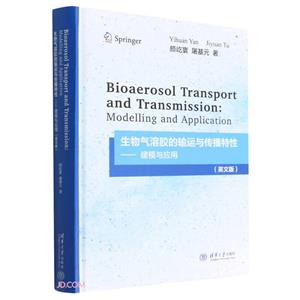-
>
宇宙、量子和人类心灵
-
>
气候文明史
-
>
南极100天
-
>
考研数学专题练1200题
-
>
希格斯:“上帝粒子”的发明与发现
-
>
神农架叠层石:10多亿年前远古海洋微生物建造的大堡礁
-
>
声音简史
生物气溶胶的运输与传播特性 建模与应用 版权信息
- ISBN:9787302603801
- 条形码:9787302603801 ; 978-7-302-60380-1
- 装帧:80g胶版纸
- 册数:暂无
- 重量:暂无
- 所属分类:>
生物气溶胶的运输与传播特性 建模与应用 本书特色
《生物气溶胶的输运与传播特性—建模与应用(英文版)》将病毒,细菌等有机生物体的活性,致病率,含水量等特性与气溶胶的物理传播特征相耦合,实现一体化模拟与预测,同时通过模拟数据对感染分析进行评估与预测,透彻分析生物气溶胶传输特性,有效评估人体潜在感染风险。
生物气溶胶的运输与传播特性 建模与应用 内容简介
作为作者过往多年间从事生物气溶胶、颗粒与气态污染物在多种室内高人口密度环境内传播特性及暴露人员健康风险评估相关研究的结合与总结,本书通过独特的视角,从流体力学角度出发,遵循气溶胶类感染物的物理传播特性,辅以计算模拟预测,分析还原了传染性气溶胶从感染者体内释放,到*终被吸入后在他人呼吸道内传输沉积的完整过程。本书的另一特色在于通过将传染性气溶胶的生物特性参数与计算流体力学相结合,提供了一套可量化的健康感染风险评估体系。其成果在科技部国家重点基础研究发展计划(“973”计划)、国家自然科学基金等多个项目的资助下完成。 本书的研究内容属交叉学科,可供建筑环境、生物工程、生物化学、流行病学、公共卫生、病理学等专业的学生及研究人员参考。
生物气溶胶的运输与传播特性 建模与应用 目录
1.1 Emerging Respiratory Pandemics
1.2 Transmission Modes
1.3 From the Fluid Dynamics Perspective
1.3.1 Exhalation
1.3.2 Transport Characteristics in the Air
1.3.3 Exposure and Inhalability
1.3.4 Deposition in Human Respiratory System
1.4 Research Method
1.5 CFD Application to Transmission Control
References
Chapter 2 Bioaerosol Dynamics
2.1 What is Bioaerosol
2.2 Types of Bioaerosols
2.3 Properties of Bioaerosol
2.3.1 Size Distribution
2.3.2 Kinetic Properties
2.3.3 Biological Properties
2.4 Motion in the Air
2.5 Dynamic Size Distribution
2.5.1 Evaporation and Condensation
2.5.2 Influential Factors
2.6 Deposition Mechanism
2.7 Summary
References
Chapter 3 Respiratory-based Bioaerosol Infections
3.1 Bioaerosol in the Air
3.2 Bioaerosol Inhalation and Deposition in Human Respiratory System
3.2.1 The Human Respiratory System
3.2.2 Concept and Physical Basis of Inhalability
3.2.3 Definition and Physical Basis of Deposition
3.2.4 Local and Total Respiratory Tract Deposition
3.2.5 Biological Mechanisms of Clearance and Redistribution
3.3 Bioaerosol-related Infections
3.4 Chain Infection due to Bioaerosol Transmission
3.5 Bioaerosol Infection Control
3.6 Summary
References
Chapter 4 Computational Fluid Dynamics
4.1 Introduction
4.2 Principles of CFD and Equations
4.3 Turbulent Flow and Models
4.4 Bioaerosol Transport Models
4.4.1 Lagrangian Model
4.4.2 Eulerian Model
4.5 CFD Workftlow and Scheme
4.6 Current Status of CFD Software
4.7 Summary
References
Chapter 5 Effects of Occupant's Micro-environment on Bioaerosol Transport
5.1 Introduction
5.2 Metabolic Body Heat and Thermal Plume
5.2.1 Characteristic of the Thermal Plume for Sitting Posture
5.2.2 Interactions between Thermal Plume and Respiratory Flow
5.2.3 Plume Effect on the Contaminant Field
5.3 Computational Thermal Manikins
5.3.1 Four Simplification Approaches
5.3.2 Case Study of the CTM Simplification Approaches in an Enclosed Chamber
5.4 Quantifiable Simplification Approach for CTMs
5.4.1 Mesh Decimating Algorithm
5.4.2 Effect of MDA Simplification on Global Airfliow Field
5.4.3 Effect of MDA Simplification on Human Micro-environment
5.4.4 Case Study-Micro-environment of CTMs using Various Simplification Approaches
5.5 Thermal Airflow Field
5.5.1 Case Study-An Enclosed Chamber
5.5.2 Case Study-A Reduced-scale Cabin Environment
5.6 Summary
References
Chapter 6 Bioaerosol Transport in Occupied Environments
6.1 Introduction
6.2 Tracking Models of Bioaerosol Transport
6.2.1 The Lagrangian Approach
6.2.2 The Eulerian Approach
6.2.3 Bioaerosol Concentration and Distribution Transport
6.2.4 Case Study-Bioaerosol Transport in a Small Chamber
6.3 Impacts of Indoor Ventilation Scheme
6.3.1 Case Study-Comparison of the Displacement and Mixing Ventilation in a Small Chamber
6.3.2 Case Study-Effect of the Ventilation Layouts in a Conference Room
6.4 Bioaerosol Transport in Densely Occupied Environment
6.4.1 Case Study-A Typical Cabin Environment
6.4.2 Case Study-A Public Transport Train Cabin
6.4.3 Case Study-A Large-scale Airliner Cabin Environment
6.5 Summary
References
Chapter 7 Influential Factors on Bioaerosol Transport
7.1 Introduction
7.2 Effect of Dynamic Droplets Size Distribution in Indoor Spaces
7.2.1 Droplets Size Distribution from Various Respiratory Behaviour
7.2.2 Droplets Size Reduction due to Evaporation
7.2.3 Case Study–Dynamic Size Reduction of Cough Released Bioaerosols and Droplets due to Evaporation
7.2.4 Case Study–Interactions between Human Thermal Plume and Cough Released Droplets
7.2.5 Delayed Droplets Deposition
生物气溶胶的运输与传播特性 建模与应用 作者简介
颜屹寰,现于墨尔本皇家墨尔本理工大学(RMIT)任研究员,致力于研究污染物在室内及建筑环境内的传播以及评估人体暴露在污染物下的感染风险,有着丰富的在大尺度机舱环境下的模拟经验及技巧,并深入分析了机舱环境等高人口密度环境下污染物传播的主要影响因素。深入参与了国家重点基础研究发展计划(973计划),大型客机座舱内空气环境控制的关系科学问题研究,曾获得澳洲博士生奖学金(APA)全奖,以及国家优秀自费留学生奖学金(全球仅500名)。
- >
李白与唐代文化
李白与唐代文化
¥9.9¥29.8 - >
伊索寓言-世界文学名著典藏-全译本
伊索寓言-世界文学名著典藏-全译本
¥6.7¥19.0 - >
莉莉和章鱼
莉莉和章鱼
¥14.4¥42.0 - >
罗曼·罗兰读书随笔-精装
罗曼·罗兰读书随笔-精装
¥32.9¥58.0 - >
月亮与六便士
月亮与六便士
¥19.1¥42.0 - >
诗经-先民的歌唱
诗经-先民的歌唱
¥14.5¥39.8 - >
我与地坛
我与地坛
¥16.4¥28.0 - >
经典常谈
经典常谈
¥16.7¥39.8
-
13次时空穿梭之旅
¥18.7¥59 -
勒维特之星-大发现系列丛书
¥5¥16 -
中国古代天文历法与二十四节气
¥20.2¥40 -
DZZ4型自动气象站维修手册
¥34¥60 -
多模态地理实体表征方法研究
¥60¥88 -
中国气象灾害大典。陕西卷
¥19¥60
初中数学核心素养行为表现及教学案例研究
¥44.5¥69.0高等数学
¥49.3¥69.0基于文化生态理念的建筑设计方法研究
¥45.2¥59.0秘境高黎贡
¥108.0¥150.0基于Python的通信原理仿真
¥55.5¥78.9

















